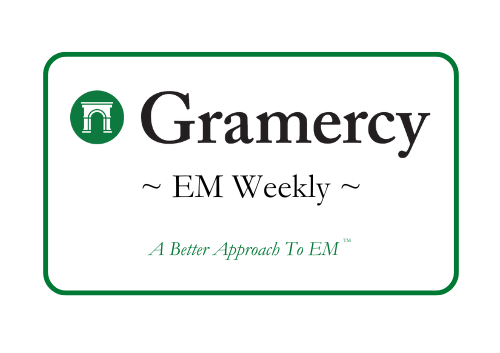Contents
Market Overview
Macro Update
Global markets remained under pressure this week as trade uncertainty raised prospects of a recession in the United States. On Wednesday, President Donald Trump imposed a 25% tariff on all steel and aluminum imports, intensifying global trade tensions as retaliatory measures were quickly announced by trading partners. This move is expected to drive up prices on a wide range of products for U.S. consumers, further stoking fears of stagflation and recession. In this context, downward revisions to 2025 U.S. GDP growth continue, with Goldman Sachs revising their 2.4% year-over-year projection down to 1.7%. While February CPI came in softer than expected at 2.8% year-over-year and the JOLTS report signaled continued labor market resilience, markets brushed off these releases as backward looking.
The long-held consensus market view of U.S. exceptionalism came under scrutiny. U.S. stock indexes struggled with the S&P 500, Nasdaq and Dow Jones down 3.0%, 2.9% and 1.3%, respectively, on the week. The S&P 500 entered correction territory on Thursday by closing more than 10% below its February high. On Friday, stocks were rebounding 1%-2% as the prospects of a U.S. government shutdown on March 15th decreased, despite University of Michigan’s March preliminary index on consumer sentiment hitting a two-year low at 57.9. Long-term inflation expectations also rose to 3.9%, the largest increase since 1993.
The DXY found stability just below 104 after a sharp drop from January’s 110 peak, while gold surpassed $3,000 for the first time, and Brent crude edged up to $70. The 10-year U.S. Treasury yield stabilized at 4.3%.
In Europe, Germany’s industrial production exceeded expectations, rising 2% month-over-month in January, driven by strong car production. The government’s plans for higher military and infrastructure spending could boost GDP growth by 100bps-200bps. On Friday, Chancellor-in-waiting Friedrich Merz indicated he has reached a tentative deal with the Greens on the spending package, including €500bn for infrastructure spending. Final Harmonized CPI for February was revised down to 2.6% year-over-year, from 2.8% in Germany and confirmed at 0.9% year-over-year in France, a positive sign for ECB policymakers. In the UK, GDP contracted by 0.1% month-over-month in January, falling short of expectations.
In China, stocks surged, with the CSI 300 Index gaining 2.4%, as officials prepared to announce new measures to stimulate consumption next week.
Elsewhere, the Bank of Canada cut its policy rate by 25bps to 2.75%, citing trade tensions with the U.S. as a growing concern. In Brazil, inflation accelerated in February, though underlying economic activity appears to be slowing.
Geopolitically, negotiations over the Ukraine conflict dominated headlines. U.S. and Ukrainian officials proposed a 30-day ceasefire in Saudi Arabia, but Moscow rejected the idea, signaling a hardline stance in talks.
EM Credit Update
Despite the volatility in U.S. equity markets, EM fixed income markets were relatively resilient with EM hard currency corporates and sovereigns down only 0.1% and 0.3%, respectively, on the week. Spreads were wider by 9bps and 6bps, respectively. In the sovereign space, investment grade and high yield performed in line, while in the corporate space, high yield underperformed slightly with a -0.2% return (vs. -0.1% for IG). Amid stable U.S. Dollar and U.S. Treasury rates, EM local currency sovereign bonds outperformed, down only 0.1% on the week.
Idiosyncratic sovereign moves were very muted this week. Senegal and Mozambique outperformed, with some partial reversal of the recent fiscal audit weakness in the case of the former, and a $5bn external financing for an LNG project in the case of the latter. There were no new sovereign issues this week, but corporate activity remained strong, with 26 deals coming to the market across EM regions.
The Week Ahead
Markets will be awaiting the FOMC rate decision and forecasts on Wednesday, as well as other indicators of U.S. economic health such as retail sales, housing starts, industrial production, mortgage application and initial jobless claims. In China, investors will look forward to the release of February economic data, which is expected to show a pickup in retail sales and steady investment, as well as the Bank of China rate decision. Other central bank decisions include Brazil (consensus +100bps to 14.25%), Indonesia (hold 5.75%), Taiwan (hold 2.0%), South Africa (hold 7.50%), Chile (hold 5.00%), Russia (hold 21.0%), Japan (hold 0.5%), Switzerland (-25bps to 0.25%), UK (hold 4.5%), and Sweden (hold 2.25%).
Fixed Income
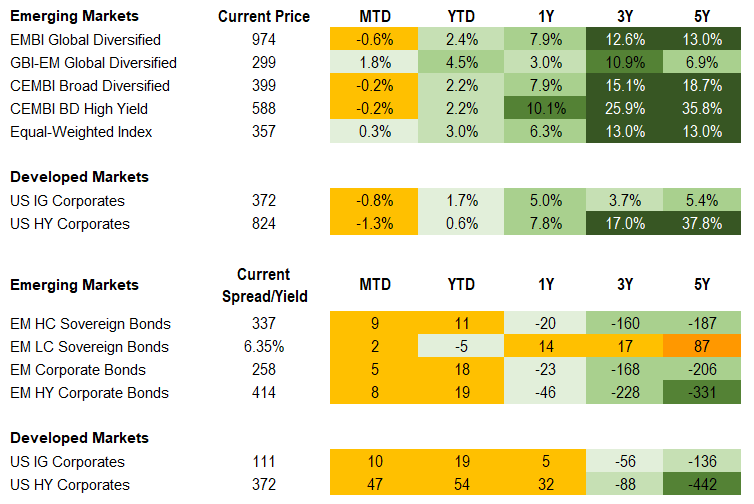
Equities
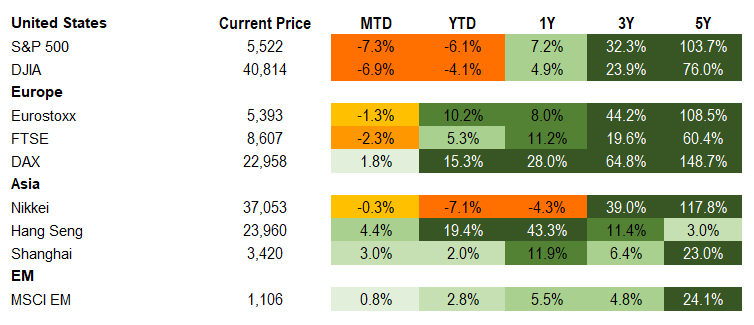
Commodities

Source for data tables: Bloomberg, JPMorgan, Gramercy. EM Fixed Income is represented by the following JPMorgan Indicies: EMBI Global, GBI-EM Global Diversified, CEMBI Broad Diversified and CEMBI Broad High Yield. DM Fixed Income is represented by the JPMorgan JULI Total Return Index and Domestic High Yield Index. Fixed Income, Equity and Commodity data is as of March 14, 2025 (mid-day).
Country Highlights
Russia Sets Tough Conditions for Ukraine Ceasefire, Talks Continue
Event: U.S. and Ukrainian delegations met in Jeddah, Saudi Arabia this week and agreed to propose “an immediate, interim 30-day ceasefire, which can be extended by mutual agreement of the parties, and which is subject to acceptance and concurrent implementation by the Russian Federation”. Russian President Vladimir Putin responded with a hard line against concessions, although he said he welcomed the talks. The Trump Administration was represented by Secretary of State Marco Rubio and National Security Advisor Michael Waltz, who signaled that “Russian reciprocity is the key to achieving peace”. Concurrently, the U.S. lifted the pause on intelligence sharing and security assistance to Ukraine.
Gramercy Comment: The outcome was constructive from Ukraine’s perspective, given the resumption of U.S. security assistance and of critically important intelligence sharing. Moscow rejected an immediate cease-fire, and the Kremlin remained focused on the notion of “lasting peace” that “takes into account Russia’s interests and concerns”.
In other words, we expect President Putin to fully embrace the idea of ending the conflict, but only on terms heavily favorable to Russia. Accepting an arrangement catering to Russia’s “maximum objectives” remains enormously problematic for President Volodymyr Zelenskiy and his European allies. Ukrainian public opinion is heavily in favor (~75% according to recent polls) of continued fighting even if the U.S. withdraws all support.
The issue of U.S. support will be a crucial factor in the upcoming, multi-layered negotiations as both Moscow and Kyiv will try to charm the White House and point the finger to the other side for not negotiating in good faith and being “the impediment to peace”.
Egypt Gets IMF Program Disbursement and Access to New Fund Facility
Event: The IMF Executive Board approved the fourth review of Egypt’s Extended Fund Facility (EFF) and disbursed $1.2 billion to the Egyptian authorities. Additionally, the Board approved the government’s request for access to a $1.3 billion Resilience and Sustainability Facility and completed the 2025 Article IV consultation. The IMF commended the authorities on their policies to preserve macroeconomic stability, particularly considering the geopolitical dynamics in the region that have resulted in a drop in Suez Canal receipts.
Gradual economic recovery, moderation in inflation, and fiscal consolidation remain underway, while moderate easing of medium-term fiscal targets was granted upon Egyptian authorities’ request. Lastly, the EFF continued to emphasize that structural reforms, which spur private sector growth, normalize energy prices, and address climate adaptation and mitigation, will be key to economic resilience. Egypt’s EMBIGD spread tightened roughly 15bps intra-week.
Gramercy Comment: The successful EFF review and access to new financing are credit positives for Egypt. While the EFF’s assessment is rightfully cautious, with risks still skewed to the downside, the continued progress on key macroeconomic policy measures such as FX flexibility, fiscal consolidation, and inflation should help to anchor bond spreads. On inflation, February’s headline CPI data fell to 12.8% year-over-year, comfortably below the IMF’s fiscal year 24/25 year-end forecast of 16.6% year-over-year and the deposit rate of 27.25%. This should allow the CBE (Central Bank of Egypt) to begin to cautiously lower rates. Lastly, while still temporary in nature, the reprieve in fighting in Gaza is also credit positive.
South Africa’s 2025 Ongoing Budget Disputes Likely to Be Resolved
Event: Finance Minister Enoch Godongwana presented the amended 2025 budget which had been delayed since February 19th due to a disagreement over VAT rates. The budget outlined a main deficit of 4.7% of GDP for fiscal year 2024/25, 4.4% of GDP for fiscal year 2025/26 and reduced the cumulative VAT hike from 2% to 1% over the next two years. The DA (Democratic Alliance), the main center-right coalition partner of the ruling center-left ANC (African National Congress), remained in disagreement with the VAT adjustment. From a macroeconomic perspective, the budget estimates 2025 real GDP growth of 1.9% and inflation of 4.3%. The rand was slightly weaker in the aftermath.
Gramercy Comment: We expect eventual resolution of disagreements between the two main GNU (Government of National Unity) parties and passage of the budget. The delay and negotiation are a function of the still relatively new and complex GNU and we believe the DA will look for concessions between now and the deadline to pass the fiscal framework on April 2nd.
We do not rule out passage of the framework without DA support or an ultimate deal struck with the DA on the appropriations bill that needs to be passed by July. The near-term uncertainty, combined with the price impact of the VAT hike, could result in a more cautious approach to monetary policy by the South Africa Reserve Bank.
Ghana’s 2025 Budget Reflects Slippage but Commitment to Consolidation
Event: Finance Minister Cassiel Ato Forson presented the 2025 budget with headline and primary balance targets of -3.1% and 1.5% of GDP, respectively. This compares to 2024’s overall and primary balance levels of -7.9% of GDP and -3.9 of GDP, respectively, which reflects just under 4.4% of GDP of slippage relative to last year’s overall fiscal deficit target. Ghana’s EMBID spread was roughly 10bps wider on the week, as much of the budget risk was previously priced in by the market.
Gramercy Comment: The fiscal slippage is negative, albeit less negative than in previous electoral cycles. We see the commitment by President John Mahama and Finance Minister Forson to fiscal responsibility as constructive. But we see room for a longer-than-typical IMF review as targets are re-worked with the new administration.
Emerging Markets Technicals
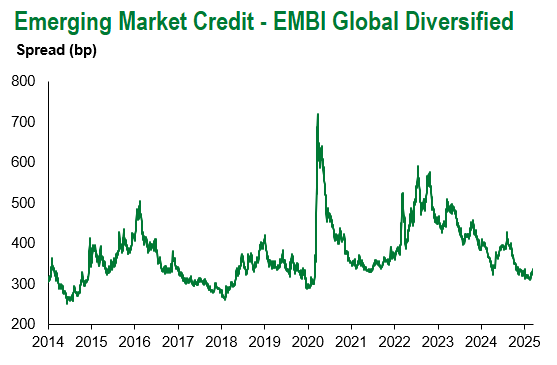
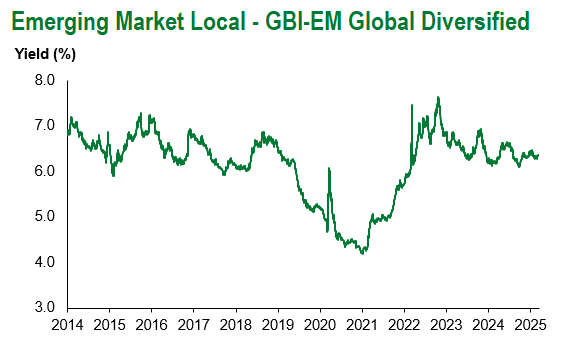
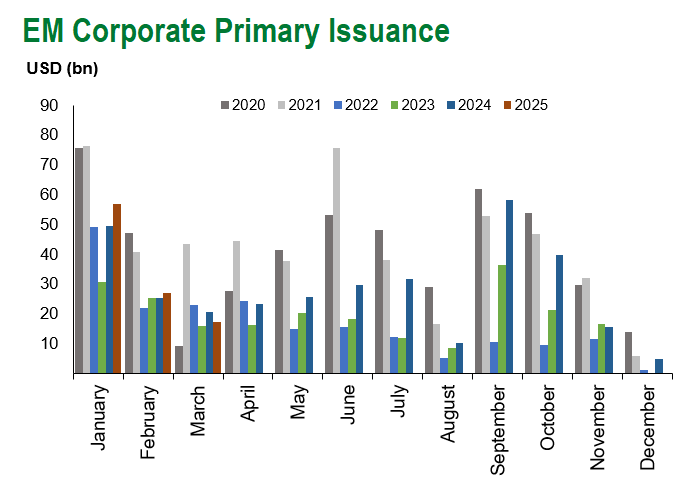
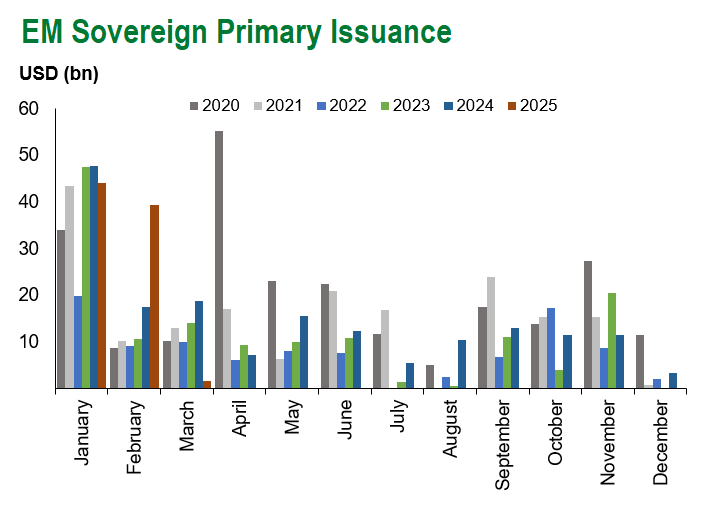
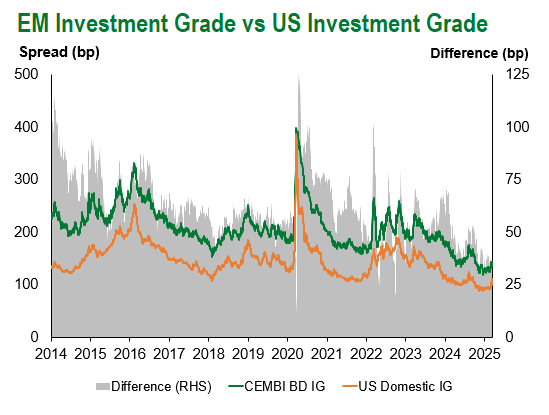
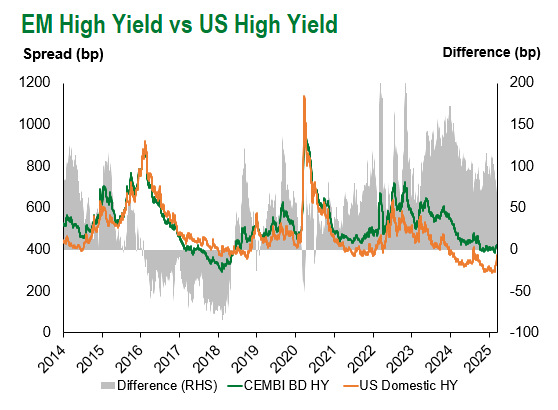
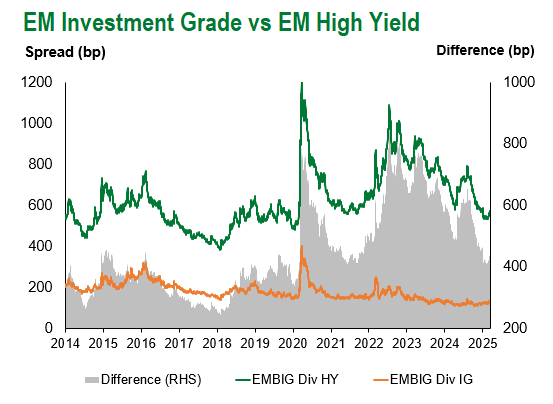
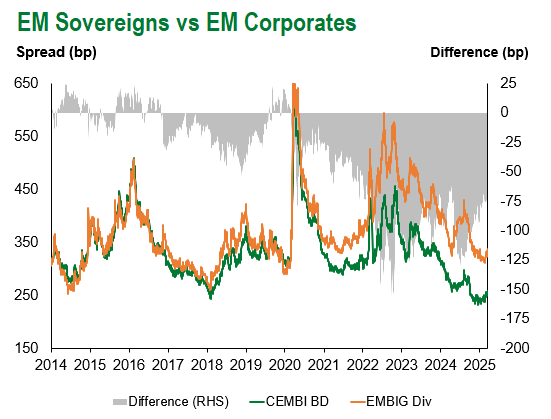
Emerging Markets Flows
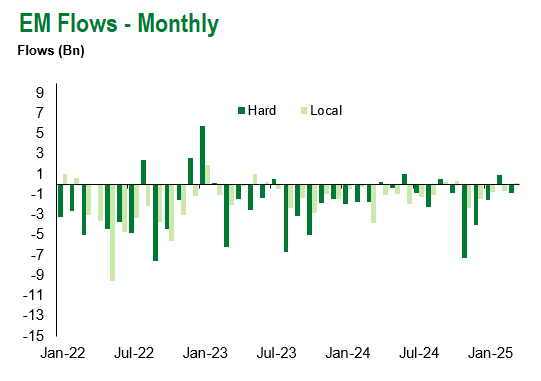
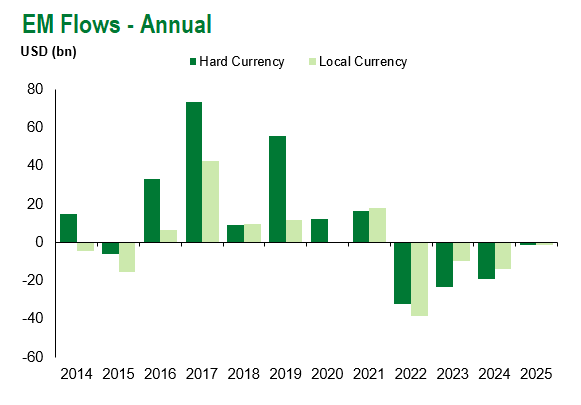
Source for graphs: Bloomberg, JPMorgan, Gramercy. As of March 14, 2025.
For questions, please contact:
Kathryn Exum, CFA ESG, Director, Co-Head of Sovereign Research, [email protected]
Petar Atanasov, Director, Co-Head of Sovereign Research, [email protected]
This document is for informational purposes only. The information presented is not intended to be relied upon as a forecast, research or investment advice, and is not a recommendation, offer or solicitation to buy or sell any securities or to adopt any investment strategy. Gramercy may have current investment positions in the securities or sovereigns mentioned above. The information and opinions contained in this paper are as of the date of initial publication, derived from proprietary and nonproprietary sources deemed by Gramercy to be reliable, are not necessarily all-inclusive and are not guaranteed as to accuracy. This paper may contain “forward-looking” information that is not purely historical in nature. Such information may include, among other things, projections and forecasts. There is no guarantee that any forecasts made will come to pass. Reliance upon information in this paper is at the sole discretion of the reader. You should not rely on this presentation as the basis upon which to make an investment decision. Investment involves risk. There can be no assurance that investment objectives will be achieved. Investors must be prepared to bear the risk of a total loss of their investment. These risks are often heightened for investments in emerging/developing markets or smaller capital markets. International investing involves risks, including risks related to foreign currency, limited liquidity, less government regulation, and the possibility of substantial volatility due to adverse political, economic or other developments. References to any indices are for informational and general comparative purposes only. The performance data of various indices mentioned in this update are updated and released on a periodic basis before finalization. The performance data of various indices presented herein was current as of the date of the presentation. Please refer to data returns of the separate indices if you desire additional or updated information. Indices are unmanaged, and their performance results do not reflect the impact of fees, expenses, or taxes that may be incurred through an investment with Gramercy. Returns for indices assume dividend reinvestment. An investment cannot be made directly in an index. Accordingly, comparing results shown to those of such indices may be of limited use. The information provided herein is neither tax nor legal advice. Investors should speak to their tax professional for specific information regarding their tax situation.
